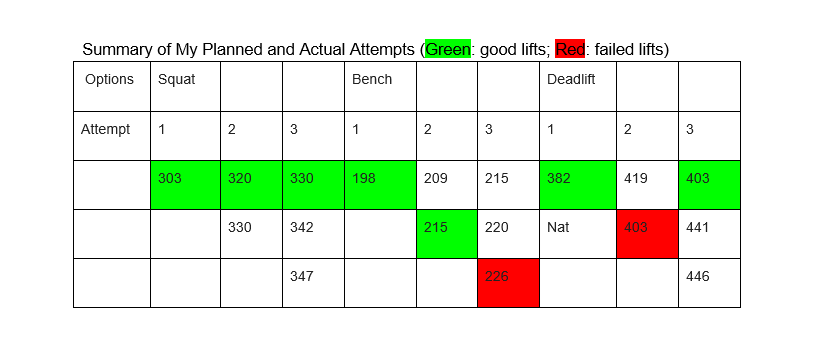Introduction: There is no certainty; there is only adventure
My first powerlifting meet was a great challenge and learning experience. My goal was to get a 942 lbs. total to qualify for USA Powerlifting Collegiate Nationals in the 182 lbs. raw weight class. With five weeks to prepare, I was confident I would succeed, but realized there were many obstacles to overcome. These challenges included that I had never used a belt before, had no experience with sumo deadlifting, had just injured my elbow which had kept me from benching for a month, only high bar squat, and didn’t know how to max out a lift.
Peter was instrumental through this entire process. Without him I would have made completely wrong decisions in every step of my preparation. In fact, ever since I’ve been training with Peter it constantly amazes (and somewhat frustrates) me how he always turns out to be right whenever our opinions disagree. It’s incredible to think about how much I still have to learn about training and how my body functions.
Preparation: The chains of habit
Of my five weeks leading up to competition, weeks 1-2 were aimed at practicing squatting heavy with a belt, developing my deadlift technique, and getting my elbow well enough that I could bench pain-free. Weeks 3-5 were used to develop my warm up progressions, test my openers, and fully recover for the meet. The most challenging, and failed, part of my preparation was changing my squat depth. Powerlifters typically use a low bar squat and descend only until the crease of their hips drop below the top of their knees. I am a high bar squatter who squats far below what is required for powerlifting, which made my squat inefficient. I wasn’t able to correct this problem in training or in competition. As you can see in the picture, in my final squat at 330 lbs., my hips and even my 4 inch wide belt were below my knees. That was deep.
Competition: The man is nothing–the work is everything
I slept for 3 hours the night before the competition, got out of bed at 5:30am and got to the competition at 6:30am for equipment check. Everyone at the meet was friendly and helped me throughout the day. I spent most of the day with another first time competitor and his coach.

During my first squat attempt I was completely thrown off by the lights, the 50 people staring at me, and having to follow the judge’s commands. I squatted with a form I never use and was essentially falling forward when I completed the lift. But, I got 2 white lights and had 303 lbs. on the board. I spent the 10 minutes between attempts essentially mentally rehearsing the steps of a squat that are usually automatic for me. After mentioning the environment was affecting me the coach I was talking to said 1) it’s just like people watching you in the gym and 2) no one in the crowd knows anything about lifting so everything looks impressive to them. The next attempts at 320 lbs. and 330 lbs. were much easier.
For a first meet, lifters aim to be successful at all 9 attempts because every lift is a PR and there is no need to kill yourself. During the bench I lost my chance at going 9/9 by failing my 3rd attempt at 225 lbs., finishing with 215 lbs. on the board.
Deadlift was intense–more mentally than physically. Warming up felt normal and my opener at 382 lbs. felt fine. Then I set my next lift to 403 lbs. to set my total at 497 lbs. and qualify for nationals. My max deadlift is about 440 lbs., so 403 lbs. was going to be easy. However, when I took my attempt, the bar didn’t even leave the ground. While waiting for my next lift in the warm up room I had never felt such a singular need to have something. There was no way I was going to go home a failure. Fortunately, when the next attempt came I made the lift and finished the meet a success.
Conclusion: Art is long; life is short
I am thankful for the opportunity to compete and see how my training has prepared me thus far. It’s amazing how much I was able to learn about lifting during this process that I might have never had the chance to without completing.
About the author:
Tyler Paras – Prevail Intern
B.S. – Cellular Molecular Biology (Westmont)
Matriculating M.D. Candidate – University of Pittsburgh School of Medicine
Tyler was born and raised in Santa Barbara, California and began training at Prevail in 2016. He attended Westmont College and will be attending medical school this fall. While at Westmont he graduated Summa Cum Laude, led a student-run homeless outreach program, and volunteered with medical clinics in Mexico and Bolivia.
After Tyler’s mother was diagnosed with rheumatoid arthritis (RA), he became interested in the cellular mechanisms behind the disease. He conducted his Major Honors project at Westmont on the role of the microbiome in inflammatory arthritis and conducted summers of research at Harvard Medical School studying the role of macrophages in RA. Including his critical care clinical research at Cottage Hospital, his research has resulted in seven presentations, three at national medical conferences.
